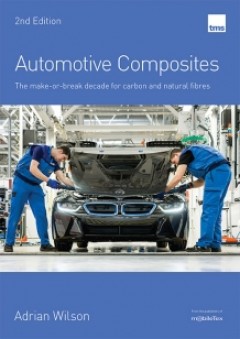Automotive Composites
The make-or-break decade for carbon and natural fibres (2nd edition)
This updated 2nd edition reviews the use of composites in the automotive sector and assesses how far these materials are from being used in mass vehicle production.
Written by Adrian Wilson, this in-depth report, with around 220 pages more than 60 tables, provides a sustainable roadmap for the automotive composites industry for the next decade and beyond. It includes detailed analyses of the production and markets for carbon fibres, glass fibres and natural fibres, and profiles of leading suppliers of these input materials.
Publication date September 2015
ISBN 978-0-9573-6165-2
HALF PRICE OFFER £245 GBP
(was £495)
To order by credit card, please select Add to cart below
You can also download an order form for payments by email, telephone or mail order
Alternatively, please contact us and we will invoice accordingly. Please also contact us for pricing details of print format plus PDF
The report will be despatched by airmail and/or email on receipt of payment. Please allow up to 14 days for airmail delivery

Full product description
The global composites industry – around 90% of which is currently glass fibre-based – is now worth an estimated €80bn, and over the past five years, automotive and transportation has grown to become its biggest sector by tonnage.
Composite materials have been used for non-structural car parts since the 1950s. In recent decades, automotive interiors have been increasingly produced from thermoplastics, with semi-structural parts now widely made from thermoset composites.
In the aircraft, boat building and racing/sports car sectors, the use of carbon fibre composites has grown rapidly in recent years. In the aerospace industry, for example, carbon fibre-based composite parts in the aircraft body now account for more than 50% of the total weight of the latest models, such as the Airbus A380 and Boeing 787 Dreamliner.
In general, composite materials are lighter in weight than steel or aluminium, which provides engineers with a lightweight alternative for use in a wide range of automotive structures and components. High strength and lighter weight leading to better fuel efficiency are the key benefits that composites offer the automotive sector; greater design flexibility, enhanced aesthetics and improved durability are other advantages.
But there are several reasons why advanced composites have not been more widely adopted by the automotive industry. The key stumbling block is price, while the availability and future supply of carbon fibres is another issue that is being addressed by fibre producers.
Many companies, from carbon fibre suppliers through to original equipment manufacturers (OEMs), are now entering the market, with a wave of partnerships and joint ventures announced over recent months. Meanwhile, there are ongoing attempts to replace glass fibre with natural fibres, such as flax and hemp.
The burning question preoccupying the automotive industry is just how far carbon can succeed in replacing today’s metal structures.
Company profiles
This new report from TMS features profiles of leading suppliers and users of carbon, glass and natural fibres, including:
- Lamborghini
- McLaren
- BMW
- Toray Industries
- Toho Tenax
- Mitsubishi
- SGL
- Hexcel
- Zoltek
- Owens Corning
- Johns Manville
- 3B
- PPG Industries
- AGY
- EcoTechnilin
- Borgers
- AFT Plasturgie



